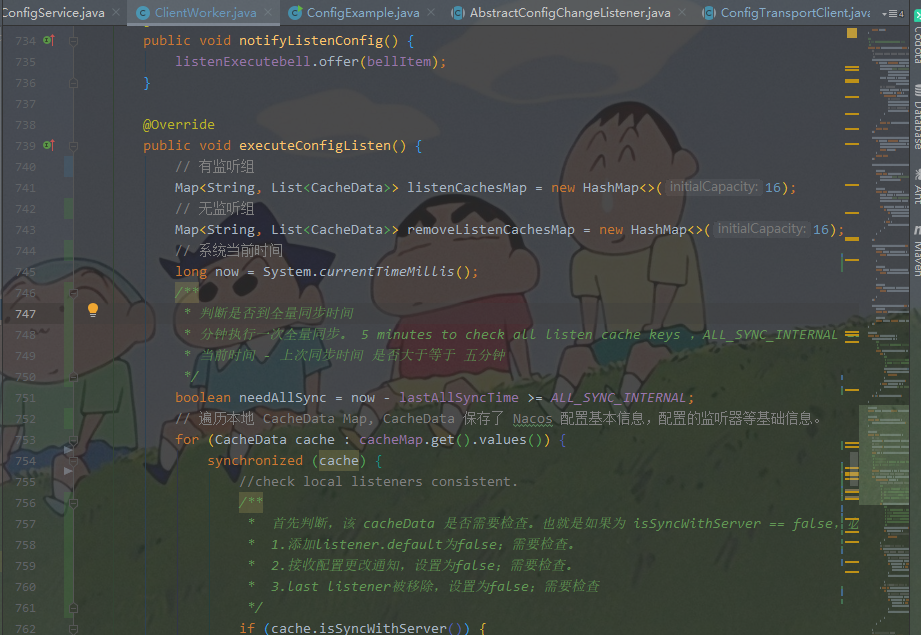Nacos 动态配置原理
Nacos 动态配置原理
可怜夜半虚前席,不问苍生问鬼神。
简介
动态配置管理是 Nacos 的三大功能之一,通过动态配置服务,我们可以在所有环境中以集中和动态的方式管理所有应用程序或服务的配置信息。
动态配置中心可以实现配置更新时无需重新部署应用程序和服务即可使相应的配置信息生效,这极大了增加了系统的运维能力。
从Nacos 2.1.1 源码中简单了解其动态配置原理。
动态配置
下面通过一个简单的例子来了解下 Nacos 的动态配置的功能,看看 Nacos 是如何以简单、优雅、高效的方式管理配置,实现配置的动态变更的。
环境准备
源码获取
首先我们要准备一个 Nacos 的服务端,这里通过 Git 命令下载代码资源包的方式获取 Nacos 的服务端。
git clone https://github.com/alibaba/nacos.git
Git 命令下载Nacos服务端源码
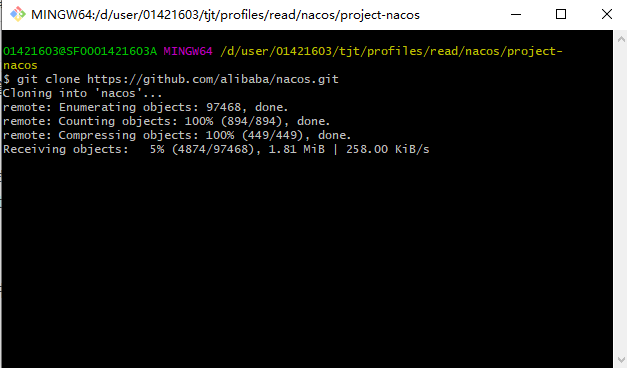
项目构建
把通过 Git 命令下载的源码包导入 IDEA 中构建Nacos服务端项目,导入后 IDEA 后可以看到在项目目录下有一个BUILDING文件,里面有构建命令。
mvn -Prelease-nacos -Dmaven.test.skip=true clean install -U
项目构建指引

执行构建成功之后将会在控制台看到BUILD SUCCESS 相关INFO 打印。
构建成功

然后在项目的 distribution 模块的 target 目录下我们就可以找到可执行程序和两个压缩包,这两个压缩包就是nacos 的 github 官网上发布的 Release 包。
- nacos-server-2.1.1.tar.gz
- nacos-server-2.1.1.zip
以及nacos 的可执行程序,即Windows 和 Linux 下的开启和关闭命令。
- startup.sh
- shutdown.sh
- startup.cmd
- shutdown.cmd
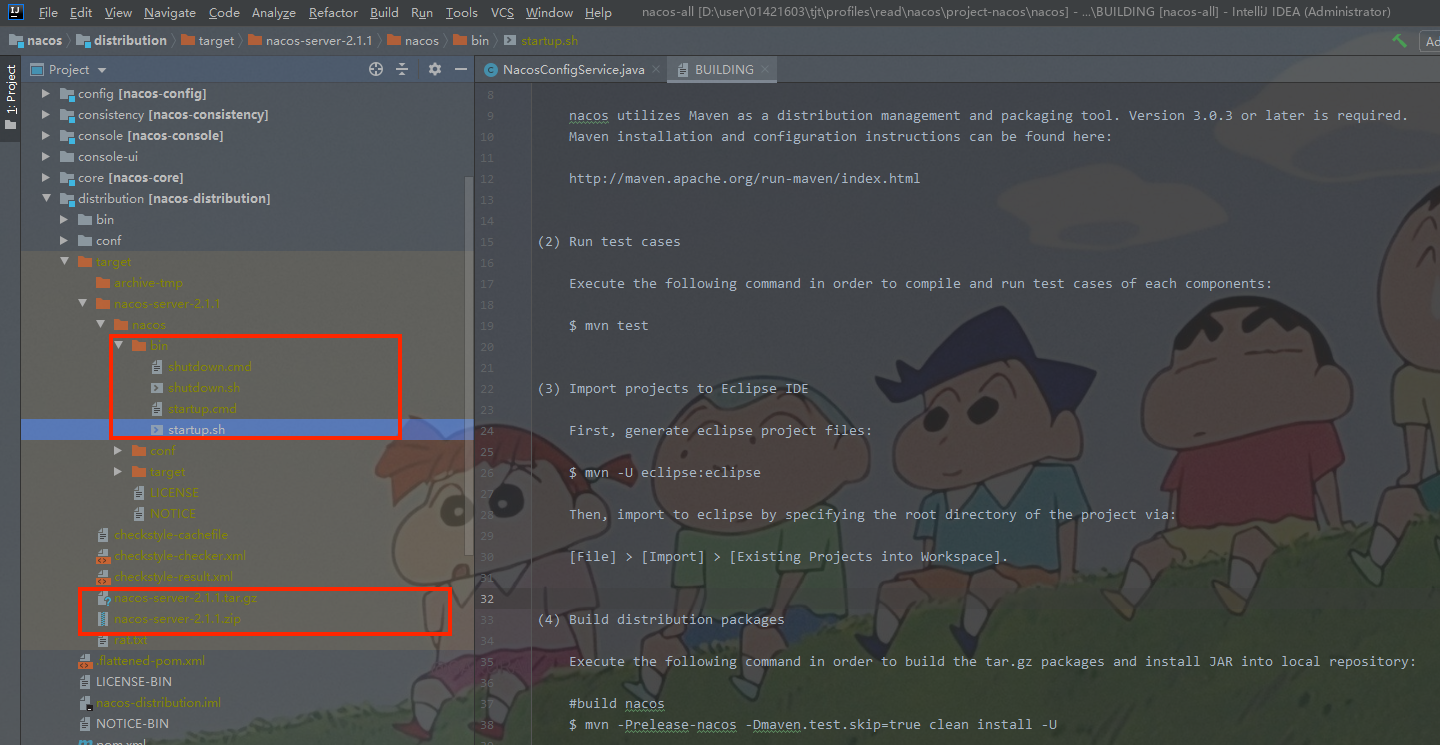
- 接下来我们把编译好的两个压缩包拷贝出来,然后解压出来直接使用,这样就相当于我们在官网上下载了 Release 包了。
- 解压后文件结构和 nacos-server-2.1.1 一样,我们直接执行 startup.sh 即可启动一个单机的 Nacos 服务端了。
- 前面这些环境准备的步骤,如果不需要修改nacos源码,完全可以直接在网上下载Nacos 的Release 包,解压后即可启动运行nacos。
启动服务端
当前安装的nacos版本:Nacos 2.1.1。
启动命令
解压后CMD到bin 目录下执行启动命令来启动一个 Nacos 服务端,Window系统直接双击 startup.cmd 即可。
可执行文件-Windows

启动报错
org.springframework.context.ApplicationContextException: Unable to start web server; nested exception is org.springframework.boot.web.server.WebServerException: Unable to start embedded Tomcat
startup.cmd 启动报错

修复启动报错
nacos 默认的启动方式是集群启动,单机使用集群启动配置就会导致启动报错。
set MODE="cluster"
编辑 startup.cmd 可执行文件,修改启动模式
set MODE="standalone"
编辑 startup.cmd 可执行文件
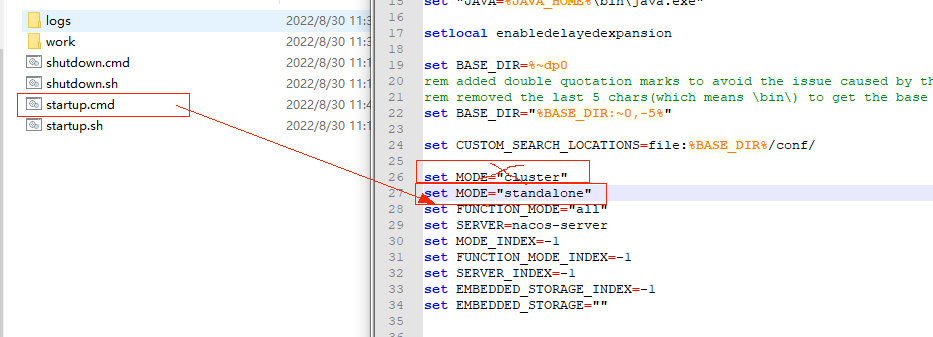
如果是非Windows 环境下运行就不会有这个问题,可以直接指定启动方式。
sh startup.sh -m standalone
启动完将会看到 INFO Nacos started successfully 相关打印。
startup.cmd 启动成功

登录
启动成功后,我们就可以在浏览器访问 Nacos 的控制台了,访问地址:http://localhost:8848/nacos/index.html。
Nacos首页访问
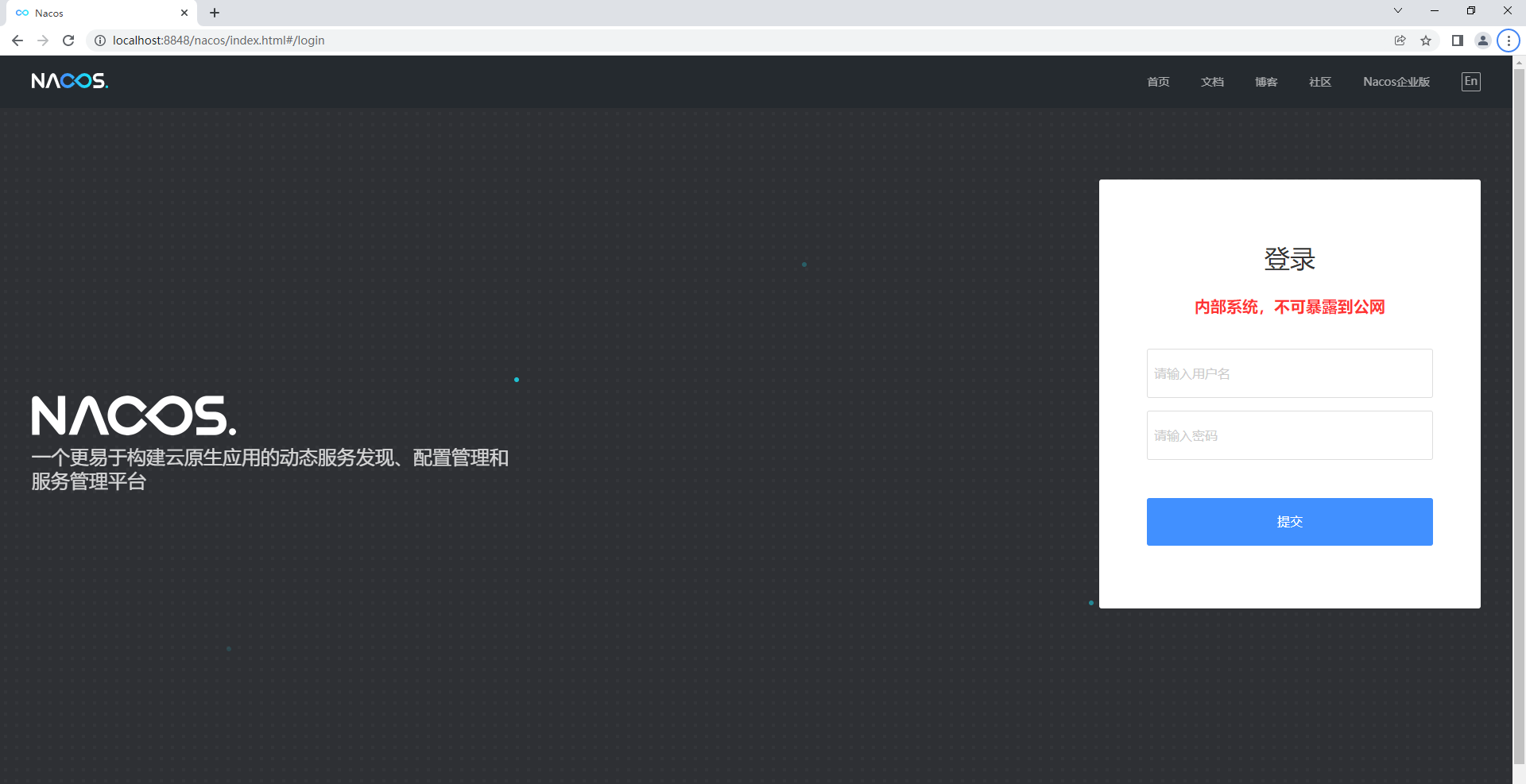
新版的nacos在首页登录界面加上了这个亮眼的标题:内部系统,不可暴露到公网,看代码提交记录是2021年2月份加的。
下载了Nacos源码这些样式我们也都可以自己的需求修改为自己想要的效果。
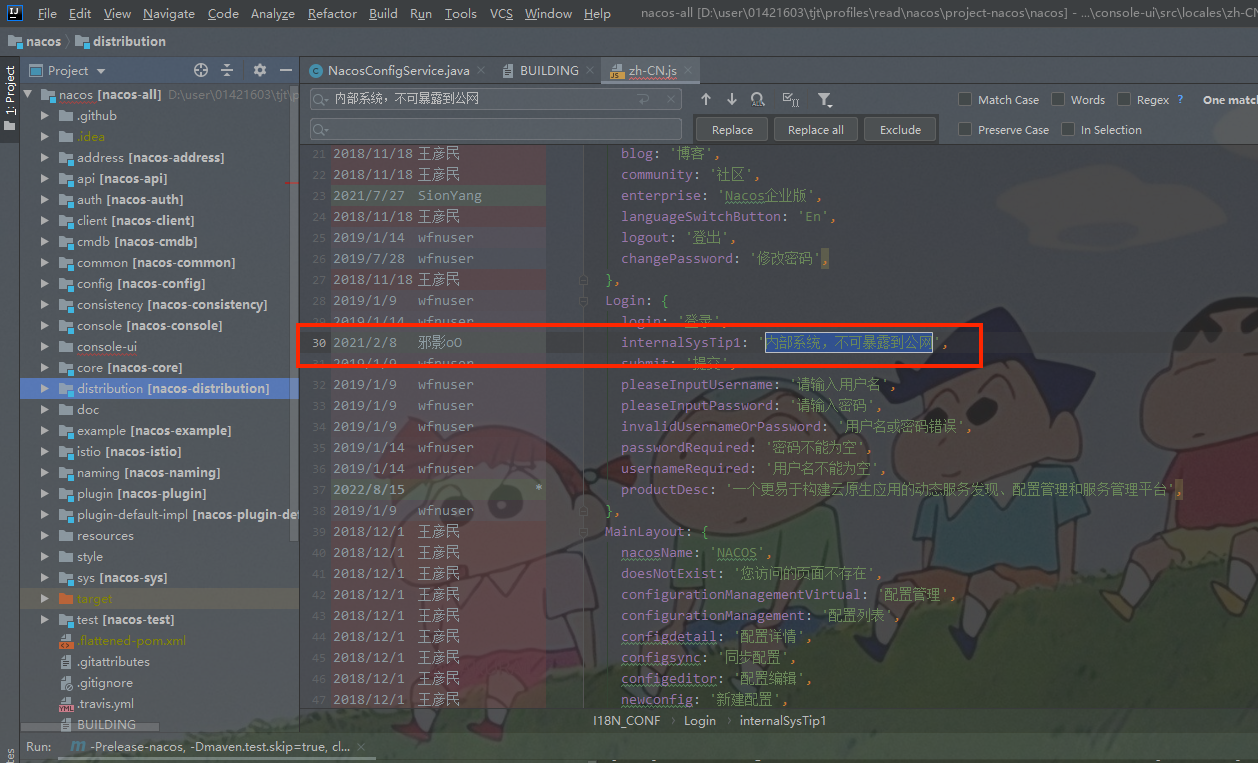
通过查看登录接口,访问地址:http://localhost:8848/nacos/v1/auth/users/login。
nacos登录接口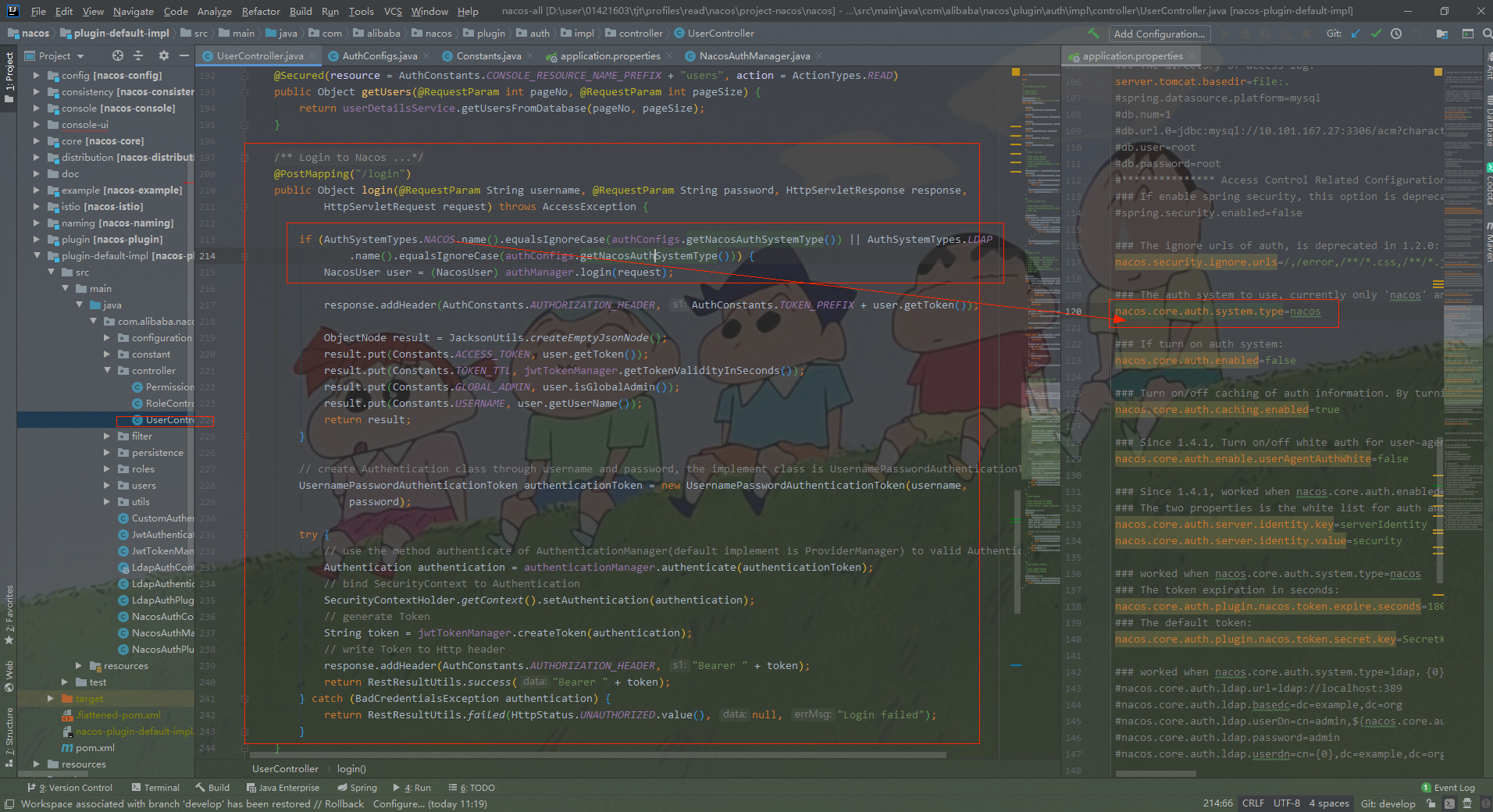
- nacos登录接口的权限控制有一个默认的账号和密码都是 nacos,也可以改为ldap。
- 就看application.properties 中的配置nacos.core.auth.system.type=nacos 当前登录用户了。
- 默认是的账号和密码都是:nacos/nacos。
登录进去之后,可以看到空白配置列表和nacos默认账户信息。
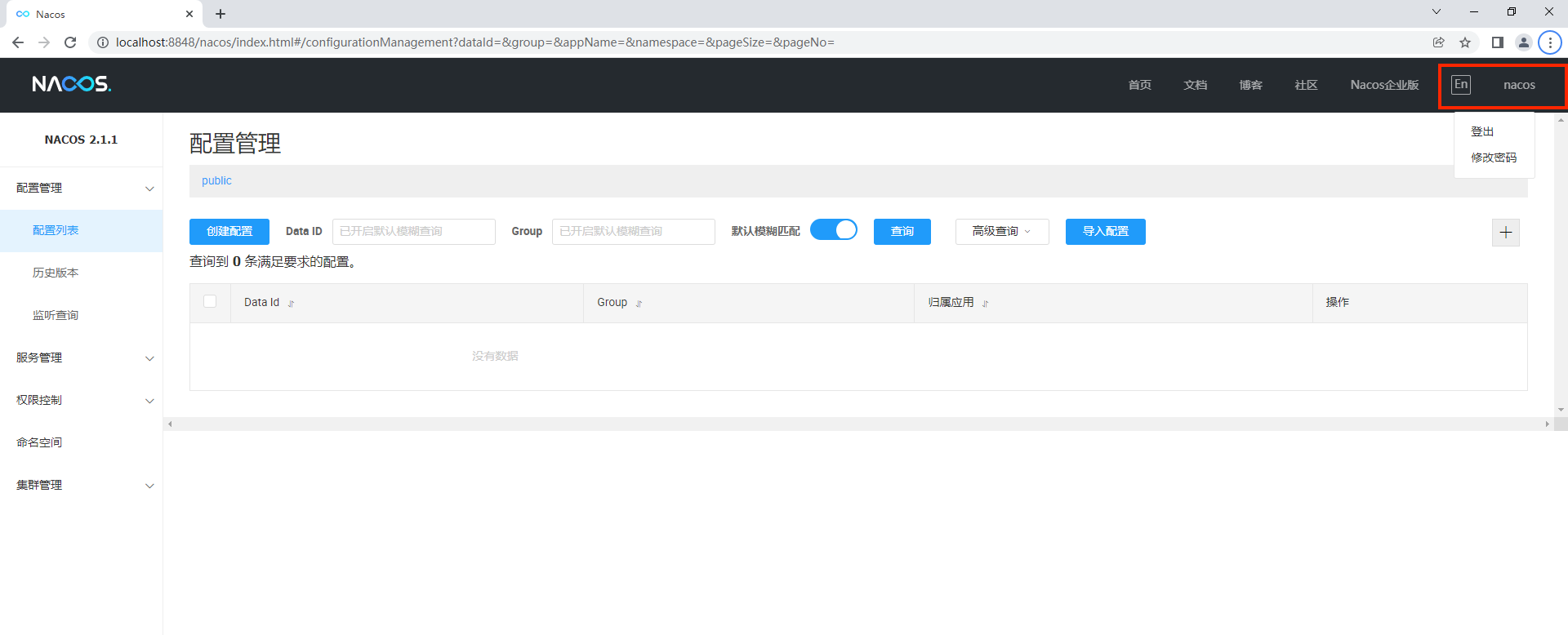
启动客户端
创建 ConfigService连接
当服务端以及配置项都准备好之后,就可以创建客户端了,如下图所示新建一个 Nacos 的 ConfigService 来接收数据。

新建配置
接下来我们在控制台上创建一个简单的配置项,如下图所示。
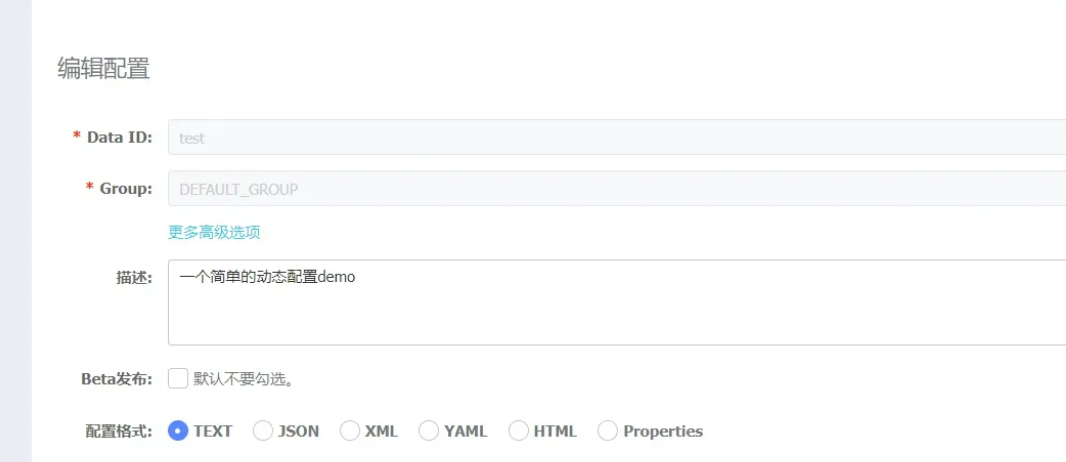
配置发布后,可以在客户端后台看到打印如下信息:
修改配置信息
接下来我们在 Nacos 的控制台上将我们的配置信息改为如下图所示:
修改完配置,点击 “发布” 按钮后,客户端将会收到最新的数据,如下图所示:
到此为止,一个简单的动态配置管理功能已经走完一遍了。
动态配置源码分析
从我们的 demo 中可以知道,我们首先是创建了一个 ConfigService。而 ConfigService 是通过 ConfigFactory 类创建的,如下图所示:
上面是通过main 方法创建测试的客户端,实际上同步配置初始化流程是由NacosConfigManager 管理。
在 NacosConfigAutoConfiguration 配置类中:

1 @Bean 2 public NacosConfigManager nacosConfigManager( NacosConfigProperties nacosConfigProperties) { 3 return new NacosConfigManager(nacosConfigProperties); 4 }
NacosConfigManager 持有:ConfigService(配置相关操作)、NacosConfigProperties(Spring Boot 对配置中心的配置)。

1 public class NacosConfigManager { 2 private static ConfigService service = null; 3 private NacosConfigProperties nacosConfigProperties; 4 5 public NacosConfigManager(NacosConfigProperties nacosConfigProperties) { 6 this.nacosConfigProperties = nacosConfigProperties; 7 createConfigService(nacosConfigProperties); 8 } 9 10 static ConfigService createConfigService( 11 NacosConfigProperties nacosConfigProperties) { 12 if (Objects.isNull(service)) { 13 // 双重加锁 防止创建了多个 NacosConfigManager 14 synchronized (NacosConfigManager.class) { 15 try { 16 if (Objects.isNull(service)) { 17 // 通过反射构造函数创建了 NacosService 的子类 18 // NacosConfigService(Properties properties) 19 service = NacosFactory.createConfigService( 20 nacosConfigProperties.assembleConfigServiceProperties()); 21 } 22 } 23 // ………… 24 } 25 } 26 return service; 27 } 28 // ………… 29 }
实例化 ConfigService
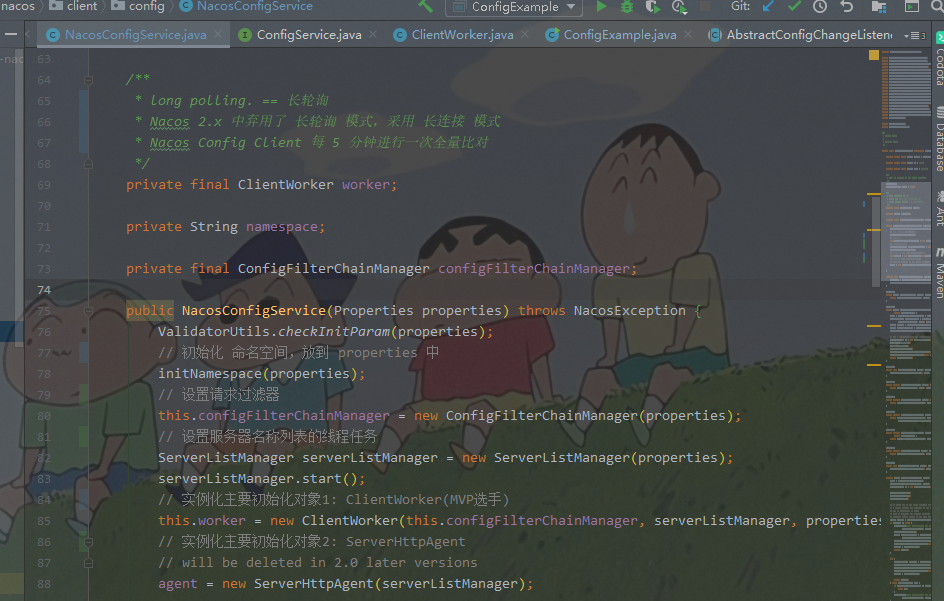

1 public NacosConfigService(Properties properties) throws NacosException { 2 ValidatorUtils.checkInitParam(properties); 3 // 初始化 命名空间,放到 properties 中 4 initNamespace(properties); 5 // 设置请求过滤器 6 this.configFilterChainManager = new ConfigFilterChainManager(properties); 7 // 设置服务器名称列表的线程任务 8 ServerListManager serverListManager = new ServerListManager(properties); 9 serverListManager.start(); 10 // 实例化主要初始化对象1: ClientWorker(MVP选手) 11 this.worker = new ClientWorker(this.configFilterChainManager, serverListManager, properties); 12 // 实例化主要初始化对象2: ServerHttpAgent 13 // will be deleted in 2.0 later versions 14 agent = new ServerHttpAgent(serverListManager); 15 16 }
ClientWorker 构造函数
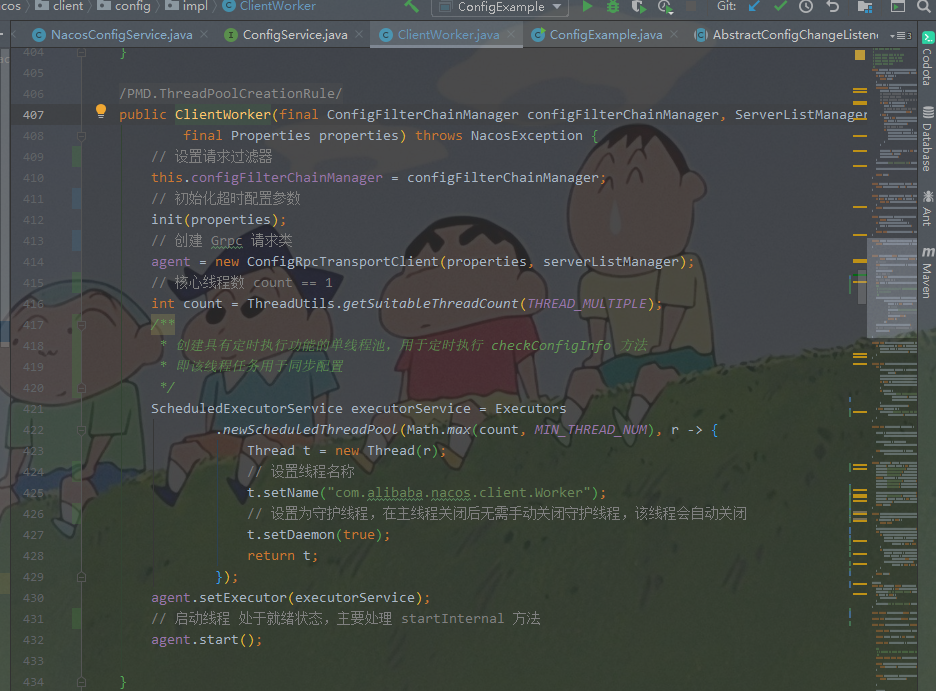

1 @SuppressWarnings("PMD.ThreadPoolCreationRule") 2 public ClientWorker(final ConfigFilterChainManager configFilterChainManager, ServerListManager serverListManager, 3 final Properties properties) throws NacosException { 4 // 设置请求过滤器 5 this.configFilterChainManager = configFilterChainManager; 6 // 初始化超时配置参数 7 init(properties); 8 // 创建 Grpc 请求类 9 agent = new ConfigRpcTransportClient(properties, serverListManager); 10 // 核心线程数 count == 1 11 int count = ThreadUtils.getSuitableThreadCount(THREAD_MULTIPLE); 12 /** 13 * 创建具有定时执行功能的单线程池,用于定时执行 checkConfigInfo 方法 14 * 即该线程任务用于同步配置 15 */ 16 ScheduledExecutorService executorService = Executors 17 .newScheduledThreadPool(Math.max(count, MIN_THREAD_NUM), r -> { 18 Thread t = new Thread(r); 19 // 设置线程名称 20 t.setName("com.alibaba.nacos.client.Worker"); 21 // 设置为守护线程,在主线程关闭后无需手动关闭守护线程,该线程会自动关闭 22 t.setDaemon(true); 23 return t; 24 }); 25 agent.setExecutor(executorService); 26 // 启动线程 处于就绪状态,主要处理 startInternal 方法 27 agent.start(); 28 29 }
ConfigRpcTransportClient
agent.start() 的 startInternal()
ConfigRpcTransportClient 的父类为 ConfigTransportClient。


1 @Override 2 public void startInternal() { 3 executor.schedule(() -> { 4 /** 5 * 启动线程任务,通过 while(true) 方式一直循环。 6 */ 7 while (!executor.isShutdown() && !executor.isTerminated()) { 8 try { 9 /** 10 * 获取队列头部元素,如果获取不到则等待5s,Nacos 通过这种方式来控制循环间隔 11 * Nacos 还可以通过调用 notifyListenConfig() 向 listenExecutebell 设置元素的方式,来立即执行 executeConfigListen() 方法 12 */ 13 listenExecutebell.poll(5L, TimeUnit.SECONDS); 14 if (executor.isShutdown() || executor.isTerminated()) { 15 continue; 16 } 17 executeConfigListen(); 18 } catch (Exception e) { 19 LOGGER.error("[ rpc listen execute ] [rpc listen] exception", e); 20 } 21 } 22 }, 0L, TimeUnit.MILLISECONDS); 23 24 }
到此处同步配置的初始化流程就完成了,我们继续看同步配置的过程。
客户端同步配置
同步配置的逻辑主要在 executeConfigListen() 方法中,这段方法比较长,需要耐心的分开来看。

1 @Override 2 public void executeConfigListen() { 3 // 有监听组 4 Map<String, List<CacheData>> listenCachesMap = new HashMap<>(16); 5 // 无监听组 6 Map<String, List<CacheData>> removeListenCachesMap = new HashMap<>(16); 7 // 系统当前时间 8 long now = System.currentTimeMillis(); 9 /** 10 * 判断是否到全量同步时间 11 * 分钟执行一次全量同步。 5 minutes to check all listen cache keys ,ALL_SYNC_INTERNAL == 5 * 60 * 1000L 12 * 当前时间 - 上次同步时间 是否大于等于 五分钟 13 */ 14 boolean needAllSync = now - lastAllSyncTime >= ALL_SYNC_INTERNAL; 15 // 遍历本地 CacheData Map, CacheData 保存了 Nacos 配置基本信息,配置的监听器等基础信息。 16 for (CacheData cache : cacheMap.get().values()) { 17 synchronized (cache) { 18 //check local listeners consistent. 19 /** 20 * 首先判断,该 cacheData 是否需要检查。也就是如果为 isSyncWithServer == false,必定进行检查。 isSyncWithServer 默认为 false 21 * 1.添加listener.default为false;需要检查。 22 * 2.接收配置更改通知,设置为false;需要检查。 23 * 3.last listener被移除,设置为false;需要检查 24 */ 25 if (cache.isSyncWithServer()) { 26 /** 27 * 执行 CacheData.Md5 与 Listener.md5的比对与设定 28 * 即本地检查 checkListenerMd5 如果不相同-配置有变化,则进行监听器的回调。 29 * 跟踪 LocalConfigInfoProcessor 方法可以查看Nacos 将配置信息保存在哪里 30 * nacos 配置保存路径:System.getProperty("JM.LOG.PATH", System.getProperty("user.home")) + File.separator + "nacos" + File.separator + "config"; 31 * C:\Users\01421603\nacos\config\fixed-localhost_8848_nacos\snapshot\DEFAULT_GROUP 32 */ 33 cache.checkListenerMd5(); 34 if (!needAllSync) { 35 // 是否需要全量同步,如果未达到全量同步时间即距上次全量同步小于五分钟,则跳过这个 cacheData,即本次循环的nacos配置无需更换 36 continue; 37 } 38 } 39 // 本地nacos配置信息 监听器不为空 走这 40 if (!CollectionUtils.isEmpty(cache.getListeners())) { 41 //get listen config ,是否启用本地监听配置 isUseLocalConfig 默认 == false 42 if (!cache.isUseLocalConfigInfo()) { 43 // 有监听器的放入 listenCachesMap 44 List<CacheData> cacheDatas = listenCachesMap.get(String.valueOf(cache.getTaskId())); 45 if (cacheDatas == null) { 46 cacheDatas = new LinkedList<>(); 47 listenCachesMap.put(String.valueOf(cache.getTaskId()), cacheDatas); 48 } 49 cacheDatas.add(cache); 50 51 } 52 // 本地nacos配置信息 监听器为空 走这 53 } else if (CollectionUtils.isEmpty(cache.getListeners())) { 54 if (!cache.isUseLocalConfigInfo()) { 55 // 没有监听器的放入 removeListenCachesMap 56 List<CacheData> cacheDatas = removeListenCachesMap.get(String.valueOf(cache.getTaskId())); 57 if (cacheDatas == null) { 58 cacheDatas = new LinkedList<>(); 59 removeListenCachesMap.put(String.valueOf(cache.getTaskId()), cacheDatas); 60 } 61 cacheDatas.add(cache); 62 63 } 64 } 65 } 66 67 } 68 // 标志是否有更改的配置,默认为 false 69 boolean hasChangedKeys = false; 70 // 有监听组配置信息 非空 71 if (!listenCachesMap.isEmpty()) { 72 for (Map.Entry<String, List<CacheData>> entry : listenCachesMap.entrySet()) { 73 String taskId = entry.getKey(); 74 Map<String, Long> timestampMap = new HashMap<>(listenCachesMap.size() * 2); 75 76 List<CacheData> listenCaches = entry.getValue(); 77 for (CacheData cacheData : listenCaches) { 78 timestampMap.put(GroupKey.getKeyTenant(cacheData.dataId, cacheData.group, cacheData.tenant), 79 cacheData.getLastModifiedTs().longValue()); 80 } 81 // 构建监听器请求 82 ConfigBatchListenRequest configChangeListenRequest = buildConfigRequest(listenCaches); 83 configChangeListenRequest.setListen(true); 84 try { 85 // 初始化 RpcClient 客户端 86 RpcClient rpcClient = ensureRpcClient(taskId); 87 /** 88 * 发送请求向 Nacos Server 添加配置变化监听器 89 * ConfigChangeBatchListenResponse 服务端将返回有变化的 dataId、group、tenant 90 */ 91 ConfigChangeBatchListenResponse configChangeBatchListenResponse = (ConfigChangeBatchListenResponse) requestProxy( 92 rpcClient, configChangeListenRequest); 93 if (configChangeBatchListenResponse != null && configChangeBatchListenResponse.isSuccess()) { 94 95 Set<String> changeKeys = new HashSet<>(); 96 //handle changed keys,notify listener 97 // 处理有变化的配置 98 if (!CollectionUtils.isEmpty(configChangeBatchListenResponse.getChangedConfigs())) { 99 hasChangedKeys = true; 100 for (ConfigChangeBatchListenResponse.ConfigContext changeConfig : configChangeBatchListenResponse 101 .getChangedConfigs()) { 102 String changeKey = GroupKey 103 .getKeyTenant(changeConfig.getDataId(), changeConfig.getGroup(), 104 changeConfig.getTenant()); 105 changeKeys.add(changeKey); 106 boolean isInitializing = cacheMap.get().get(changeKey).isInitializing(); 107 /** 108 * 刷新上下文 109 * 此处将请求 Nacos Server ,获取最新配置内容,并触发 Listener 的回调。 110 */ 111 refreshContentAndCheck(changeKey, !isInitializing); 112 } 113 114 } 115 116 //handler content configs 117 for (CacheData cacheData : listenCaches) { 118 String groupKey = GroupKey 119 .getKeyTenant(cacheData.dataId, cacheData.group, cacheData.getTenant()); 120 // 如果返回的 changeKeys 中,未包含此 groupKey。则说明此内容未发生变化。 121 if (!changeKeys.contains(groupKey)) { 122 //sync:cache data md5 = server md5 && cache data md5 = all listeners md5. 123 synchronized (cacheData) { 124 if (!cacheData.getListeners().isEmpty()) { 125 126 Long previousTimesStamp = timestampMap.get(groupKey); 127 if (previousTimesStamp != null && !cacheData.getLastModifiedTs().compareAndSet(previousTimesStamp, 128 System.currentTimeMillis())) { 129 continue; 130 } 131 // 则将同步标志设为 true 132 cacheData.setSyncWithServer(true); 133 } 134 } 135 } 136 // 将初始化状态设置 false 137 cacheData.setInitializing(false); 138 } 139 140 } 141 } catch (Exception e) { 142 143 LOGGER.error("Async listen config change error ", e); 144 try { 145 Thread.sleep(50L); 146 } catch (InterruptedException interruptedException) { 147 //ignore 148 } 149 } 150 } 151 } 152 153 /** 154 * 处理无监听器的 CacheData 155 * 无监听器的 CacheData 就是,从 Nacos Client 与 Nacos Server 中移除掉原有的监听器。 156 */ 157 if (!removeListenCachesMap.isEmpty()) { 158 for (Map.Entry<String, List<CacheData>> entry : removeListenCachesMap.entrySet()) { 159 String taskId = entry.getKey(); 160 List<CacheData> removeListenCaches = entry.getValue(); 161 ConfigBatchListenRequest configChangeListenRequest = buildConfigRequest(removeListenCaches); 162 configChangeListenRequest.setListen(false); 163 try { 164 RpcClient rpcClient = ensureRpcClient(taskId); 165 boolean removeSuccess = unListenConfigChange(rpcClient, configChangeListenRequest); 166 if (removeSuccess) { 167 for (CacheData cacheData : removeListenCaches) { 168 synchronized (cacheData) { 169 if (cacheData.getListeners().isEmpty()) { 170 ClientWorker.this 171 .removeCache(cacheData.dataId, cacheData.group, cacheData.tenant); 172 } 173 } 174 } 175 } 176 177 } catch (Exception e) { 178 LOGGER.error("async remove listen config change error ", e); 179 } 180 try { 181 Thread.sleep(50L); 182 } catch (InterruptedException interruptedException) { 183 //ignore 184 } 185 } 186 } 187 188 if (needAllSync) { 189 lastAllSyncTime = now; 190 } 191 //If has changed keys,notify re sync md5. 192 // 如果有改变的配置,则立即进行一次同步配置过程。 193 if (hasChangedKeys) { 194 notifyListenConfig(); 195 } 196 }
客户端接收服务端推送
当 Nacos Config 配置发生变更时,Nacos Server 会主动通知 Nacos Client。
Nacos Client 在向 Nacos Server 发送请求前,会初始化 Nacos Rpc Client,执行的方法是
ConfigRpcTransportClient # ensureRpcClient(String taskId)
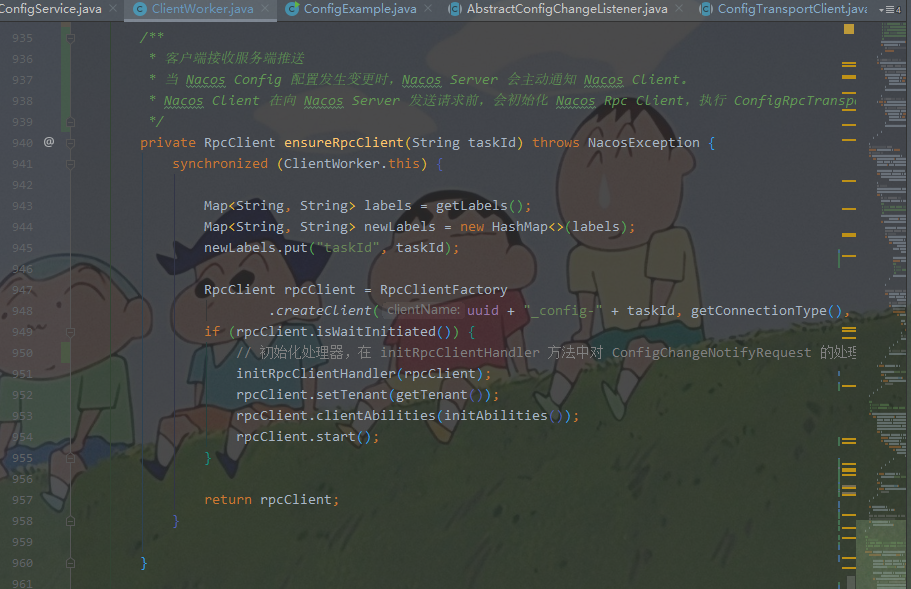

1 /** 2 * 客户端接收服务端推送 3 * 当 Nacos Config 配置发生变更时,Nacos Server 会主动通知 Nacos Client。 4 * Nacos Client 在向 Nacos Server 发送请求前,会初始化 Nacos Rpc Client,执行 ConfigRpcTransportClient下的 ensureRpcClient(String taskId) 方法 5 */ 6 private RpcClient ensureRpcClient(String taskId) throws NacosException { 7 synchronized (ClientWorker.this) { 8 9 Map<String, String> labels = getLabels(); 10 Map<String, String> newLabels = new HashMap<>(labels); 11 newLabels.put("taskId", taskId); 12 13 RpcClient rpcClient = RpcClientFactory 14 .createClient(uuid + "_config-" + taskId, getConnectionType(), newLabels); 15 if (rpcClient.isWaitInitiated()) { 16 // 初始化处理器,在 initRpcClientHandler 方法中对 ConfigChangeNotifyRequest 的处理逻辑。 17 initRpcClientHandler(rpcClient); 18 rpcClient.setTenant(getTenant()); 19 rpcClient.clientAbilities(initAbilities()); 20 rpcClient.start(); 21 } 22 23 return rpcClient; 24 } 25 26 }
初始化 ConfigChangeNotifyRequest 处理逻辑

1 /** 2 * 初始化 ConfigChangeNotifyRequest 处理逻辑 3 */ 4 private void initRpcClientHandler(final RpcClient rpcClientInner) { 5 /* 6 * Register Config Change /Config ReSync Handler 7 */ 8 rpcClientInner.registerServerRequestHandler((request) -> { 9 if (request instanceof ConfigChangeNotifyRequest) { 10 ConfigChangeNotifyRequest configChangeNotifyRequest = (ConfigChangeNotifyRequest) request; 11 LOGGER.info("[{}] [server-push] config changed. dataId={}, group={},tenant={}", 12 rpcClientInner.getName(), configChangeNotifyRequest.getDataId(), 13 configChangeNotifyRequest.getGroup(), configChangeNotifyRequest.getTenant()); 14 String groupKey = GroupKey 15 .getKeyTenant(configChangeNotifyRequest.getDataId(), configChangeNotifyRequest.getGroup(), 16 configChangeNotifyRequest.getTenant()); 17 // 获取 CacheData 18 CacheData cacheData = cacheMap.get().get(groupKey); 19 if (cacheData != null) { 20 synchronized (cacheData) { 21 // 设置服务器同步标志 22 cacheData.getLastModifiedTs().set(System.currentTimeMillis()); 23 cacheData.setSyncWithServer(false); 24 // 立即触发该 CacheData 的同步配置操作 25 notifyListenConfig(); 26 } 27 28 } 29 return new ConfigChangeNotifyResponse(); 30 } 31 return null; 32 }); 33 34 rpcClientInner.registerServerRequestHandler((request) -> { 35 if (request instanceof ClientConfigMetricRequest) { 36 ClientConfigMetricResponse response = new ClientConfigMetricResponse(); 37 response.setMetrics(getMetrics(((ClientConfigMetricRequest) request).getMetricsKeys())); 38 return response; 39 } 40 return null; 41 }); 42 43 rpcClientInner.registerConnectionListener(new ConnectionEventListener() { 44 45 @Override 46 public void onConnected() { 47 LOGGER.info("[{}] Connected,notify listen context...", rpcClientInner.getName()); 48 notifyListenConfig(); 49 } 50 51 @Override 52 public void onDisConnect() { 53 String taskId = rpcClientInner.getLabels().get("taskId"); 54 LOGGER.info("[{}] DisConnected,clear listen context...", rpcClientInner.getName()); 55 Collection<CacheData> values = cacheMap.get().values(); 56 57 for (CacheData cacheData : values) { 58 if (StringUtils.isNotBlank(taskId)) { 59 if (Integer.valueOf(taskId).equals(cacheData.getTaskId())) { 60 cacheData.setSyncWithServer(false); 61 } 62 } else { 63 cacheData.setSyncWithServer(false); 64 } 65 } 66 } 67 68 }); 69 70 rpcClientInner.serverListFactory(new ServerListFactory() { 71 @Override 72 public String genNextServer() { 73 return ConfigRpcTransportClient.super.serverListManager.getNextServerAddr(); 74 75 } 76 77 @Override 78 public String getCurrentServer() { 79 return ConfigRpcTransportClient.super.serverListManager.getCurrentServerAddr(); 80 81 } 82 83 @Override 84 public List<String> getServerList() { 85 return ConfigRpcTransportClient.super.serverListManager.getServerUrls(); 86 87 } 88 }); 89 90 NotifyCenter.registerSubscriber(new Subscriber<ServerlistChangeEvent>() { 91 @Override 92 public void onEvent(ServerlistChangeEvent event) { 93 rpcClientInner.onServerListChange(); 94 } 95 96 @Override 97 public Class<? extends Event> subscribeType() { 98 return ServerlistChangeEvent.class; 99 } 100 }); 101 } 102
服务端变更通知
入口
配置变更是在 Nacos Service 的 Web 页面进行操作的,调用POST /v1/cs/configs接口。
该接口主要逻辑:
- 更新配置内容
- 发送配置变更事件


1 /** 2 * 服务端变更通知 3 * 入口:配置变更,是在 Nacos Service 的 Web 页面进行操作的,调用POST /v1/cs/configs接口,即 publishConfig。 4 * Adds or updates non-aggregated data. 5 * <p> 6 * request and response will be used in aspect, see 7 * {@link com.alibaba.nacos.config.server.aspect.CapacityManagementAspect} and 8 * {@link com.alibaba.nacos.config.server.aspect.RequestLogAspect}. 9 * </p> 10 * @throws NacosException NacosException. 11 */ 12 @PostMapping 13 @Secured(action = ActionTypes.WRITE, signType = SignType.CONFIG) 14 public Boolean publishConfig(HttpServletRequest request, HttpServletResponse response, 15 @RequestParam(value = "dataId") String dataId, 16 @RequestParam(value = "group") String group, 17 @RequestParam(value = "tenant", required = false, defaultValue = StringUtils.EMPTY) String tenant, 18 @RequestParam(value = "content") String content, @RequestParam(value = "tag", required = false) String tag, 19 @RequestParam(value = "appName", required = false) String appName, 20 @RequestParam(value = "src_user", required = false) String srcUser, 21 @RequestParam(value = "config_tags", required = false) String configTags, 22 @RequestParam(value = "desc", required = false) String desc, 23 @RequestParam(value = "use", required = false) String use, 24 @RequestParam(value = "effect", required = false) String effect, 25 @RequestParam(value = "type", required = false) String type, 26 @RequestParam(value = "schema", required = false) String schema) throws NacosException { 27 28 final String srcIp = RequestUtil.getRemoteIp(request); 29 final String requestIpApp = RequestUtil.getAppName(request); 30 if (StringUtils.isBlank(srcUser)) { 31 srcUser = RequestUtil.getSrcUserName(request); 32 } 33 //check type 34 if (!ConfigType.isValidType(type)) { 35 type = ConfigType.getDefaultType().getType(); 36 } 37 38 // encrypted 39 Pair<String, String> pair = EncryptionHandler.encryptHandler(dataId, content); 40 content = pair.getSecond(); 41 42 // check tenant 43 ParamUtils.checkTenant(tenant); 44 ParamUtils.checkParam(dataId, group, "datumId", content); 45 ParamUtils.checkParam(tag); 46 Map<String, Object> configAdvanceInfo = new HashMap<>(10); 47 MapUtil.putIfValNoNull(configAdvanceInfo, "config_tags", configTags); 48 MapUtil.putIfValNoNull(configAdvanceInfo, "desc", desc); 49 MapUtil.putIfValNoNull(configAdvanceInfo, "use", use); 50 MapUtil.putIfValNoNull(configAdvanceInfo, "effect", effect); 51 MapUtil.putIfValNoNull(configAdvanceInfo, "type", type); 52 MapUtil.putIfValNoNull(configAdvanceInfo, "schema", schema); 53 ParamUtils.checkParam(configAdvanceInfo); 54 55 if (AggrWhitelist.isAggrDataId(dataId)) { 56 LOGGER.warn("[aggr-conflict] {} attempt to publish single data, {}, {}", RequestUtil.getRemoteIp(request), 57 dataId, group); 58 throw new NacosException(NacosException.NO_RIGHT, "dataId:" + dataId + " is aggr"); 59 } 60 61 final Timestamp time = TimeUtils.getCurrentTime(); 62 String betaIps = request.getHeader("betaIps"); 63 ConfigInfo configInfo = new ConfigInfo(dataId, group, tenant, appName, content); 64 configInfo.setType(type); 65 String encryptedDataKey = pair.getFirst(); 66 configInfo.setEncryptedDataKey(encryptedDataKey); 67 if (StringUtils.isBlank(betaIps)) { 68 if (StringUtils.isBlank(tag)) { 69 persistService.insertOrUpdate(srcIp, srcUser, configInfo, time, configAdvanceInfo, false); 70 ConfigChangePublisher.notifyConfigChange( 71 new ConfigDataChangeEvent(false, dataId, group, tenant, time.getTime())); 72 } else { 73 // 更新配置内容 74 persistService.insertOrUpdateTag(configInfo, tag, srcIp, srcUser, time, false); 75 // 发送配置变更事件 76 ConfigChangePublisher.notifyConfigChange( 77 new ConfigDataChangeEvent(false, dataId, group, tenant, tag, time.getTime())); 78 } 79 } else { 80 // beta publish 81 configInfo.setEncryptedDataKey(encryptedDataKey); 82 persistService.insertOrUpdateBeta(configInfo, betaIps, srcIp, srcUser, time, false); 83 ConfigChangePublisher.notifyConfigChange( 84 new ConfigDataChangeEvent(true, dataId, group, tenant, time.getTime())); 85 } 86 ConfigTraceService.logPersistenceEvent(dataId, group, tenant, requestIpApp, time.getTime(), 87 InetUtils.getSelfIP(), ConfigTraceService.PERSISTENCE_EVENT_PUB, content); 88 return true; 89 }
ConfigDataChangeEvent 监听器
AsyncNotifyService 在初始化时,向事件通知中心添加了监听器。
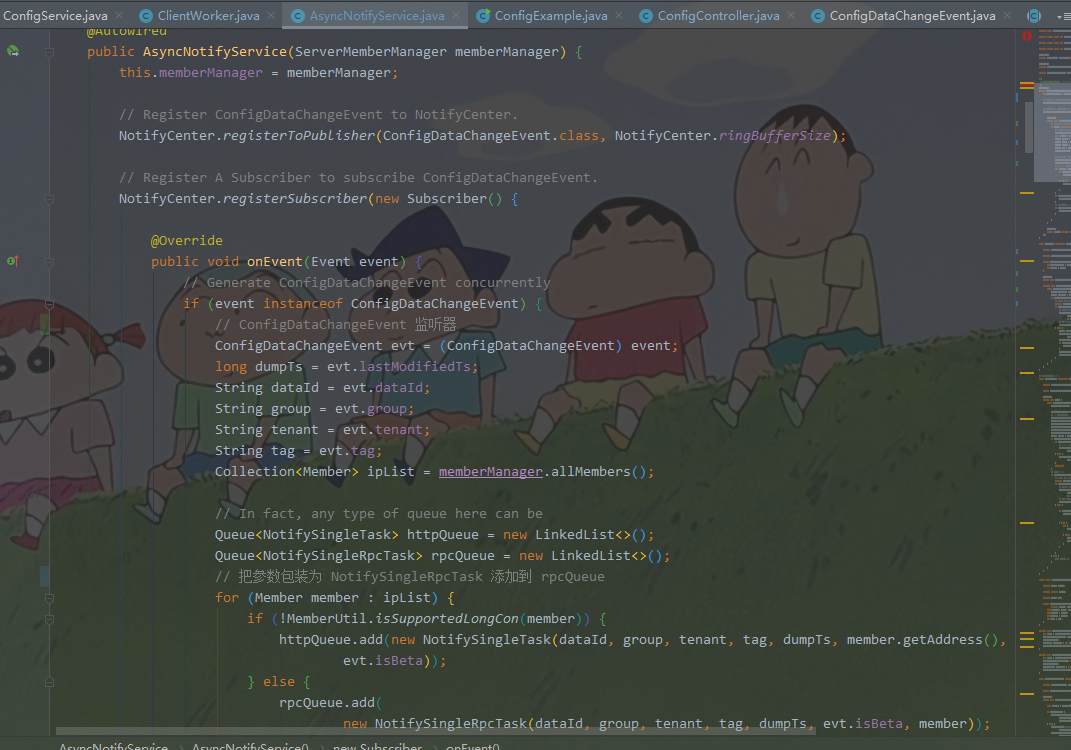

1 /** 2 * AsyncNotifyService 在初始化时,向事件通知中心添加了监听器 3 */ 4 @Autowired 5 public AsyncNotifyService(ServerMemberManager memberManager) { 6 this.memberManager = memberManager; 7 8 // Register ConfigDataChangeEvent to NotifyCenter. 9 NotifyCenter.registerToPublisher(ConfigDataChangeEvent.class, NotifyCenter.ringBufferSize); 10 11 // Register A Subscriber to subscribe ConfigDataChangeEvent. 12 NotifyCenter.registerSubscriber(new Subscriber() { 13 14 @Override 15 public void onEvent(Event event) { 16 // Generate ConfigDataChangeEvent concurrently 17 if (event instanceof ConfigDataChangeEvent) { 18 // ConfigDataChangeEvent 监听器 19 ConfigDataChangeEvent evt = (ConfigDataChangeEvent) event; 20 long dumpTs = evt.lastModifiedTs; 21 String dataId = evt.dataId; 22 String group = evt.group; 23 String tenant = evt.tenant; 24 String tag = evt.tag; 25 Collection<Member> ipList = memberManager.allMembers(); 26 27 // In fact, any type of queue here can be 28 Queue<NotifySingleTask> httpQueue = new LinkedList<>(); 29 Queue<NotifySingleRpcTask> rpcQueue = new LinkedList<>(); 30 // 把参数包装为 NotifySingleRpcTask 添加到 rpcQueue 31 for (Member member : ipList) { 32 if (!MemberUtil.isSupportedLongCon(member)) { 33 httpQueue.add(new NotifySingleTask(dataId, group, tenant, tag, dumpTs, member.getAddress(), 34 evt.isBeta)); 35 } else { 36 rpcQueue.add( 37 new NotifySingleRpcTask(dataId, group, tenant, tag, dumpTs, evt.isBeta, member)); 38 } 39 } 40 if (!httpQueue.isEmpty()) { 41 ConfigExecutor.executeAsyncNotify(new AsyncTask(nacosAsyncRestTemplate, httpQueue)); 42 } 43 // 若rpcQueue 不为空,则把 rpcQueue 包装为 AsyncRpcTask 44 if (!rpcQueue.isEmpty()) { 45 ConfigExecutor.executeAsyncNotify(new AsyncRpcTask(rpcQueue)); 46 } 47 48 } 49 } 50 51 @Override 52 public Class<? extends Event> subscribeType() { 53 return ConfigDataChangeEvent.class; 54 } 55 }); 56 }
AsyncRpcTask异步任务
AsyncRpcTask #run()


1 // AsyncRpcTask 异步任务 2 class AsyncRpcTask implements Runnable { 3 4 private Queue<NotifySingleRpcTask> queue; 5 6 public AsyncRpcTask(Queue<NotifySingleRpcTask> queue) { 7 this.queue = queue; 8 } 9 10 @Override 11 public void run() { 12 while (!queue.isEmpty()) { 13 NotifySingleRpcTask task = queue.poll(); 14 15 ConfigChangeClusterSyncRequest syncRequest = new ConfigChangeClusterSyncRequest(); 16 // 组装 syncRequest 参数 17 syncRequest.setDataId(task.getDataId()); 18 syncRequest.setGroup(task.getGroup()); 19 syncRequest.setBeta(task.isBeta); 20 syncRequest.setLastModified(task.getLastModified()); 21 syncRequest.setTag(task.tag); 22 syncRequest.setTenant(task.getTenant()); 23 Member member = task.member; 24 if (memberManager.getSelf().equals(member)) { 25 if (syncRequest.isBeta()) { 26 // 提交异步任务 dump 27 dumpService.dump(syncRequest.getDataId(), syncRequest.getGroup(), syncRequest.getTenant(), 28 syncRequest.getLastModified(), NetUtils.localIP(), true); 29 } else { 30 dumpService.dump(syncRequest.getDataId(), syncRequest.getGroup(), syncRequest.getTenant(), 31 syncRequest.getTag(), syncRequest.getLastModified(), NetUtils.localIP()); 32 } 33 continue; 34 } 35 // nacos 集群通知 36 if (memberManager.hasMember(member.getAddress())) { 37 // start the health check and there are ips that are not monitored, put them directly in the notification queue, otherwise notify 38 boolean unHealthNeedDelay = memberManager.isUnHealth(member.getAddress()); 39 if (unHealthNeedDelay) { 40 // target ip is unhealthy, then put it in the notification list 41 ConfigTraceService.logNotifyEvent(task.getDataId(), task.getGroup(), task.getTenant(), null, 42 task.getLastModified(), InetUtils.getSelfIP(), ConfigTraceService.NOTIFY_EVENT_UNHEALTH, 43 0, member.getAddress()); 44 // get delay time and set fail count to the task 45 asyncTaskExecute(task); 46 } else { 47 48 if (!MemberUtil.isSupportedLongCon(member)) { 49 asyncTaskExecute( 50 new NotifySingleTask(task.getDataId(), task.getGroup(), task.getTenant(), task.tag, 51 task.getLastModified(), member.getAddress(), task.isBeta)); 52 } else { 53 try { 54 configClusterRpcClientProxy 55 .syncConfigChange(member, syncRequest, new AsyncRpcNotifyCallBack(task)); 56 } catch (Exception e) { 57 MetricsMonitor.getConfigNotifyException().increment(); 58 asyncTaskExecute(task); 59 } 60 } 61 62 } 63 } else { 64 //No nothig if member has offline. 65 } 66 67 } 68 } 69 }
接下来继续看 dumpService.dump()


1 /** 2 * Add DumpTask to TaskManager, it will execute asynchronously. 3 * DumpTask 异步任务 4 * 该异步任务由 TaskManager 执行,其在EmbeddedDumpService初始化时,被创建。 5 * 实际由TaskManager 的父类 NacosDelayTaskExecuteEngine 执行 processTasks() 方法 6 */ 7 public void dump(String dataId, String group, String tenant, long lastModified, String handleIp, boolean isBeta) { 8 String groupKey = GroupKey2.getKey(dataId, group, tenant); 9 String taskKey = String.join("+", dataId, group, tenant, String.valueOf(isBeta)); 10 dumpTaskMgr.addTask(taskKey, new DumpTask(groupKey, lastModified, handleIp, isBeta)); 11 DUMP_LOG.info("[dump-task] add task. groupKey={}, taskKey={}", groupKey, taskKey); 12 }
DumpTask 异步任务
该异步任务由 TaskManager执行,其在EmbeddedDumpService初始化时,被创建。
实际由 TaskManager的父类 NacosDelayTaskExecuteEngine执行 processTasks()方法。


1 /** 2 * process tasks in execute engine. 3 */ 4 protected void processTasks() { 5 Collection<Object> keys = getAllTaskKeys(); 6 for (Object taskKey : keys) { 7 AbstractDelayTask task = removeTask(taskKey); 8 if (null == task) { 9 continue; 10 } 11 // 根据 taskKey 取到对应的 NacosTaskProcessor 执行 process() 方法 12 NacosTaskProcessor processor = getProcessor(taskKey); 13 if (null == processor) { 14 getEngineLog().error("processor not found for task, so discarded. " + task); 15 continue; 16 } 17 try { 18 // ReAdd task if process failed 19 if (!processor.process(task)) { 20 retryFailedTask(taskKey, task); 21 } 22 } catch (Throwable e) { 23 getEngineLog().error("Nacos task execute error ", e); 24 retryFailedTask(taskKey, task); 25 } 26 } 27 }
实际上就是根据 taskKey 取到对应的NacosTaskProcessor执行process()方法。
此处 DumpTask 对应的是 DumpProcessor。
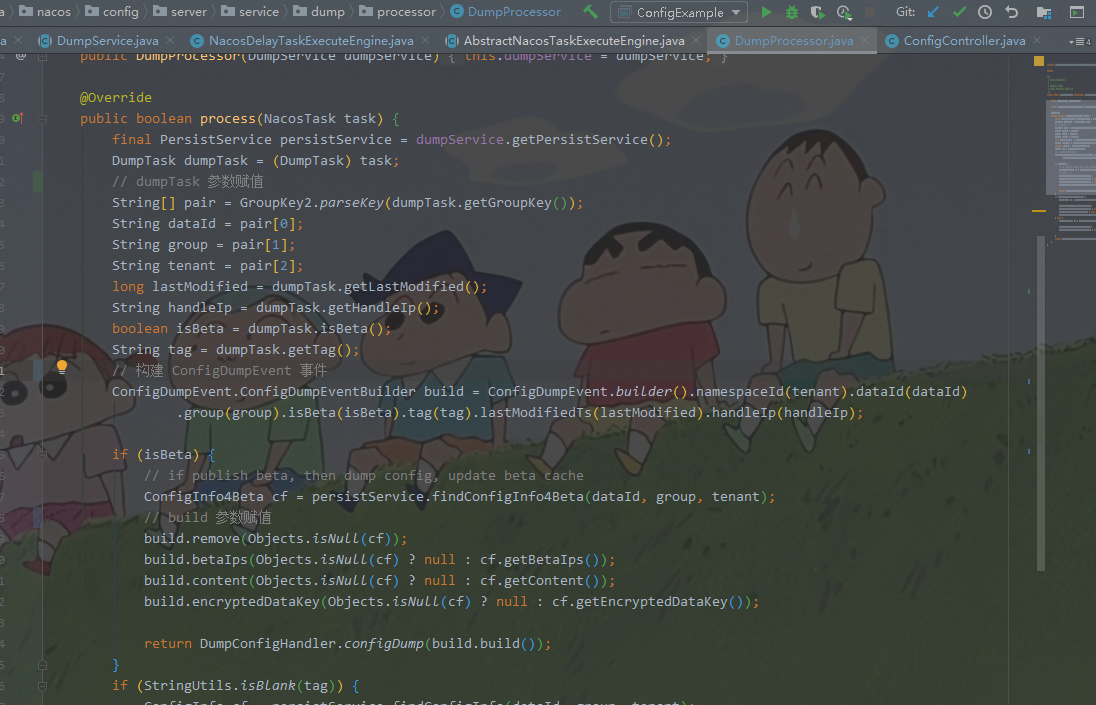

1 @Override 2 public boolean process(NacosTask task) { 3 final PersistService persistService = dumpService.getPersistService(); 4 DumpTask dumpTask = (DumpTask) task; 5 // dumpTask 参数赋值 6 String[] pair = GroupKey2.parseKey(dumpTask.getGroupKey()); 7 String dataId = pair[0]; 8 String group = pair[1]; 9 String tenant = pair[2]; 10 long lastModified = dumpTask.getLastModified(); 11 String handleIp = dumpTask.getHandleIp(); 12 boolean isBeta = dumpTask.isBeta(); 13 String tag = dumpTask.getTag(); 14 // 构建 ConfigDumpEvent 事件 15 ConfigDumpEvent.ConfigDumpEventBuilder build = ConfigDumpEvent.builder().namespaceId(tenant).dataId(dataId) 16 .group(group).isBeta(isBeta).tag(tag).lastModifiedTs(lastModified).handleIp(handleIp); 17 18 if (isBeta) { 19 // if publish beta, then dump config, update beta cache 20 ConfigInfo4Beta cf = persistService.findConfigInfo4Beta(dataId, group, tenant); 21 // build 参数赋值 22 build.remove(Objects.isNull(cf)); 23 build.betaIps(Objects.isNull(cf) ? null : cf.getBetaIps()); 24 build.content(Objects.isNull(cf) ? null : cf.getContent()); 25 build.encryptedDataKey(Objects.isNull(cf) ? null : cf.getEncryptedDataKey()); 26 27 return DumpConfigHandler.configDump(build.build()); 28 } 29 if (StringUtils.isBlank(tag)) { 30 ConfigInfo cf = persistService.findConfigInfo(dataId, group, tenant); 31 32 build.remove(Objects.isNull(cf)); 33 build.content(Objects.isNull(cf) ? null : cf.getContent()); 34 build.type(Objects.isNull(cf) ? null : cf.getType()); 35 build.encryptedDataKey(Objects.isNull(cf) ? null : cf.getEncryptedDataKey()); 36 } else { 37 ConfigInfo4Tag cf = persistService.findConfigInfo4Tag(dataId, group, tenant, tag); 38 39 build.remove(Objects.isNull(cf)); 40 build.content(Objects.isNull(cf) ? null : cf.getContent()); 41 42 } 43 return DumpConfigHandler.configDump(build.build()); 44 }
继续进入DumpConfigHandler.configDump(build.build())。

1 /** 2 * trigger config dump event. 3 * 4 * @param event {@link ConfigDumpEvent} 5 * @return {@code true} if the config dump task success , else {@code false} 6 */ 7 public static boolean configDump(ConfigDumpEvent event) { 8 final String dataId = event.getDataId(); 9 final String group = event.getGroup(); 10 final String namespaceId = event.getNamespaceId(); 11 final String content = event.getContent(); 12 final String type = event.getType(); 13 final long lastModified = event.getLastModifiedTs(); 14 final String encryptedDataKey = event.getEncryptedDataKey(); 15 if (event.isBeta()) { 16 boolean result; 17 if (event.isRemove()) { 18 result = ConfigCacheService.removeBeta(dataId, group, namespaceId); 19 if (result) { 20 ConfigTraceService.logDumpEvent(dataId, group, namespaceId, null, lastModified, event.getHandleIp(), 21 ConfigTraceService.DUMP_EVENT_REMOVE_OK, System.currentTimeMillis() - lastModified, 0); 22 } 23 return result; 24 } else { 25 result = ConfigCacheService 26 .dumpBeta(dataId, group, namespaceId, content, lastModified, event.getBetaIps(), 27 encryptedDataKey); 28 if (result) { 29 ConfigTraceService.logDumpEvent(dataId, group, namespaceId, null, lastModified, event.getHandleIp(), 30 ConfigTraceService.DUMP_EVENT_OK, System.currentTimeMillis() - lastModified, 31 content.length()); 32 } 33 } 34 35 return result; 36 } 37 if (StringUtils.isBlank(event.getTag())) { 38 if (dataId.equals(AggrWhitelist.AGGRIDS_METADATA)) { 39 AggrWhitelist.load(content); 40 } 41 42 if (dataId.equals(ClientIpWhiteList.CLIENT_IP_WHITELIST_METADATA)) { 43 ClientIpWhiteList.load(content); 44 } 45 46 if (dataId.equals(SwitchService.SWITCH_META_DATAID)) { 47 SwitchService.load(content); 48 } 49 50 boolean result; 51 if (!event.isRemove()) { 52 result = ConfigCacheService 53 .dump(dataId, group, namespaceId, content, lastModified, type, encryptedDataKey); 54 55 if (result) { 56 ConfigTraceService.logDumpEvent(dataId, group, namespaceId, null, lastModified, event.getHandleIp(), 57 ConfigTraceService.DUMP_EVENT_OK, System.currentTimeMillis() - lastModified, 58 content.length()); 59 } 60 } else { 61 result = ConfigCacheService.remove(dataId, group, namespaceId); 62 63 if (result) { 64 ConfigTraceService.logDumpEvent(dataId, group, namespaceId, null, lastModified, event.getHandleIp(), 65 ConfigTraceService.DUMP_EVENT_REMOVE_OK, System.currentTimeMillis() - lastModified, 0); 66 } 67 } 68 return result; 69 } else { 70 // 71 boolean result; 72 if (!event.isRemove()) { 73 // 保存配置文件并更新缓存中的 md5 值 74 result = ConfigCacheService 75 .dumpTag(dataId, group, namespaceId, event.getTag(), content, lastModified, encryptedDataKey); 76 if (result) { 77 ConfigTraceService.logDumpEvent(dataId, group, namespaceId, null, lastModified, event.getHandleIp(), 78 ConfigTraceService.DUMP_EVENT_OK, System.currentTimeMillis() - lastModified, 79 content.length()); 80 } 81 } else { 82 result = ConfigCacheService.removeTag(dataId, group, namespaceId, event.getTag()); 83 if (result) { 84 ConfigTraceService.logDumpEvent(dataId, group, namespaceId, null, lastModified, event.getHandleIp(), 85 ConfigTraceService.DUMP_EVENT_REMOVE_OK, System.currentTimeMillis() - lastModified, 0); 86 } 87 } 88 return result; 89 } 90 91 }
继续进入ConfigCacheService.dump()。

1 /** 2 * Update md5 value. 3 * 4 * @param groupKey groupKey string value. 5 * @param md5 md5 string value. 6 * @param lastModifiedTs lastModifiedTs long value. 7 */ 8 public static void updateMd5(String groupKey, String md5, long lastModifiedTs, String encryptedDataKey) { 9 CacheItem cache = makeSure(groupKey, encryptedDataKey, false); 10 if (cache.md5 == null || !cache.md5.equals(md5)) { 11 cache.md5 = md5; 12 cache.lastModifiedTs = lastModifiedTs; 13 // 发布 LocalDataChangeEvent 事件 14 NotifyCenter.publishEvent(new LocalDataChangeEvent(groupKey)); 15 } 16 }
LocalDataChangeEvent 监听器
RpcConfigChangeNotifier 是 LocalDataChangeEvent 的监听器。


1 /** 2 * adaptor to config module ,when server side config change ,invoke this method. 3 * 4 * @param groupKey groupKey 5 */ 6 public void configDataChanged(String groupKey, String dataId, String group, String tenant, boolean isBeta, 7 List<String> betaIps, String tag) { 8 // 获取变更配置对应的客户端 9 Set<String> listeners = configChangeListenContext.getListeners(groupKey); 10 if (CollectionUtils.isEmpty(listeners)) { 11 return; 12 } 13 int notifyClientCount = 0; 14 for (final String client : listeners) { 15 // 根据客户端获取连接 16 Connection connection = connectionManager.getConnection(client); 17 if (connection == null) { 18 continue; 19 } 20 21 ConnectionMeta metaInfo = connection.getMetaInfo(); 22 //beta ips check. 23 String clientIp = metaInfo.getClientIp(); 24 String clientTag = metaInfo.getTag(); 25 if (isBeta && betaIps != null && !betaIps.contains(clientIp)) { 26 continue; 27 } 28 //tag check 29 if (StringUtils.isNotBlank(tag) && !tag.equals(clientTag)) { 30 continue; 31 } 32 // 构造请求 33 ConfigChangeNotifyRequest notifyRequest = ConfigChangeNotifyRequest.build(dataId, group, tenant); 34 // 构造任务 35 RpcPushTask rpcPushRetryTask = new RpcPushTask(notifyRequest, 50, client, clientIp, metaInfo.getAppName()); 36 // 发送请求 37 push(rpcPushRetryTask); 38 notifyClientCount++; 39 } 40 Loggers.REMOTE_PUSH.info("push [{}] clients ,groupKey=[{}]", notifyClientCount, groupKey); 41 } 42 43 @Override 44 public void onEvent(LocalDataChangeEvent event) { 45 String groupKey = event.groupKey; 46 boolean isBeta = event.isBeta; 47 List<String> betaIps = event.betaIps; 48 String[] strings = GroupKey.parseKey(groupKey); 49 String dataId = strings[0]; 50 String group = strings[1]; 51 String tenant = strings.length > 2 ? strings[2] : ""; 52 String tag = event.tag; 53 54 configDataChanged(groupKey, dataId, group, tenant, isBeta, betaIps, tag); 55 56 }
发送请求
发送请求的逻辑在RpcPushTask # run()中。


1 /** 2 * 发送请求的逻辑在RpcPushTask # run() 中 3 */ 4 @Override 5 public void run() { 6 tryTimes++; 7 if (!tpsMonitorManager.applyTpsForClientIp(POINT_CONFIG_PUSH, connectionId, clientIp)) { 8 // 如果 tps 受限,自旋等待 tps 控制放开。 9 push(this); 10 } else { 11 // 发送请求 12 rpcPushService.pushWithCallback(connectionId, notifyRequest, new AbstractPushCallBack(3000L) { 13 @Override 14 public void onSuccess() { 15 tpsMonitorManager.applyTpsForClientIp(POINT_CONFIG_PUSH_SUCCESS, connectionId, clientIp); 16 } 17 18 @Override 19 public void onFail(Throwable e) { 20 tpsMonitorManager.applyTpsForClientIp(POINT_CONFIG_PUSH_FAIL, connectionId, clientIp); 21 Loggers.REMOTE_PUSH.warn("Push fail", e); 22 push(RpcPushTask.this); 23 } 24 25 }, ConfigExecutor.getClientConfigNotifierServiceExecutor()); 26 27 } 28 29 }
总结
Nacos 2.x 中抛弃了之前版本的 长轮询 模式,采用 长连接 模式。
- 在长轮询的任务中,当服务端配置信息发生变更时,客户端将最新的数据获取下来之后,保存在了 CacheData 中,同时更新了该 CacheData 的 md5 值,所以当下次执行 checkListenerMd5 方法时,就会发现当前 listener 所持有的 md5 值已经和 CacheData 的 md5 值不一样了,也就意味着服务端的配置信息发生改变了,这时就需要将最新的数据通知给 Listener 的持有者。
- Nacos 并不是通过推的方式将服务端最新的配置信息发送给客户端的,而是客户端维护了一个长轮询的任务,定时去拉取发生变更的配置信息,然后将最新的数据推送给 Listener 的持有者。
- Nacos Config Client 每 5 分钟进行一次全量比对。
- Nacos Config Server 有配置发生变化时,发布
LocalDataChangeEvent,监听器监听到该事件,即开始向 Nacos Config Client 发送ConfigChangeNotifyRequest。Nacos Config Client 感到到有配置发生变化,向 Nacos Config Server 发送ConfigQueryRequest请求最新配置内容。 - 客户端拉取服务端的数据与服务端推送数据给客户端相比,优势在于其 Nacos 不设计成主动推送数据,而是要客户端去拉取。如果用推的方式,服务端需要维持与客户端的长连接,这样的话需要耗费大量的资源,并且还需要考虑连接的有效性,例如需要通过心跳来维持两者之间的连接。而用拉的方式,客户端只需要通过一个无状态的 http 请求即可获取到服务端的数据。
可怜夜半虚前席
不问苍生问鬼神




